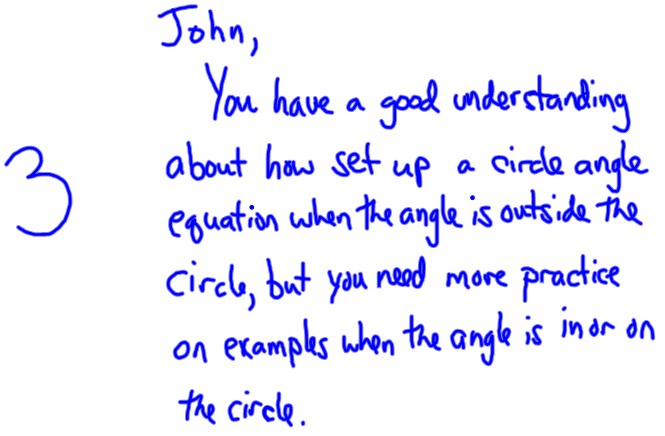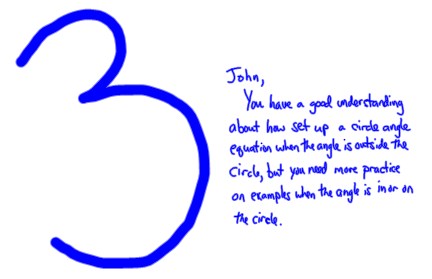The grading system in Geometry this year was described to the students with the following description:
The final concept grade will be out of a grade of 8. The best you can do on the first quiz is a 4 out of 8 (50%). Every concept will quizzed at least twice. If the second grade is higher than the previous grade, then you double the new grade. Otherwise you add the two grades together. Here are some examples:
- 3 on the first, 4 on the second, means a 8 / 8 grade
- 2 on the first, 2 on the second, means a 4 / 8 grade
- 4 on the first, 3 on the second, means a 7 / 8 grade
- 2 on the first, 2 on the second, 4 on the optional (after school) quiz, means a 8 / 8 grade
That is how the grading system ran for three quarters. For the fourth quarter, I made one small change: The first assessment of a concept was not graded and just feedback was given. In reality this meant that their grade for an assessment was based solely on one assessment, and this was usually a week behind when we actually worked on that concept in class.
At first they didn’t like the change because I think they were relying on the grade to tell them all the information. But after a week they had gotten used to it and I heard no complains.
Pros To Feedback Only On The First Assessment
- Students actually read the feedback and they asked more questions about stuff they didn’t get.
- Students moved one step up a cognitive scale. They took the feedback and tried to put themselves in my shoes and give themselves a grade.
“Oh, I’d only get a 3.5 because I screwed up solving the equation.”
“This is only a 1 or 2 because I have no idea what I’m doing on this concept.” - Despite my initial fears, the students still worked on a concept quiz that they knew wasn’t going to be graded. I was worried that they’d leave it blank, or give it a cursory try, but there was no drop in effort on the first assessment.
- My grade book became a lot easier to manage and explain. The grade on the second look was their grade and any reassessments after school simply replaced the old grade.
Cons To Feedback Only On The First Assessment
- Many students still walked into the second reassessment over confident despite the feedback on their first assessment. They knew that they could retake if they needed and buy cialis online legally so not enough effort was being made to knock the assessment out of the park on the first pitch that counted.
- Sometimes a kid’s grade on a concept may be a bit lower. If they would have gotten a 4 then a 3.5 on the second assessment then their old grade would be a 7.5/8 and their new grade would be a 7/8. Not a biggie, but it lead to some unnecessary reassessments for the few grade grubbers that I have.
Feedback Thoughts
Overall I’ve increased the length and breadth of my feedback to the students. After being goaded into writing more feedback, I’ve written more on students quizzes than ever before.
I started the year off by giving a grade and some feedback.
To me it looks like this:

But to most students it looks like this:

So I’ve come up with the following inequality (nerd!) to describe the situation:
Feedback > Feedback + Grade > Grade
Do you have any feedback? If you do give me feedback with a grade, be careful, I may not read the feedback carefully.
Update (6/17/2011): Just found this post from (6/6/2011) that talks about very similar things in a great way: http://symmetricblog.wordpress.com/2011/06/06/sbf/

10 Responses to SBG: A Small Tweak and a Feedback Inequality
Pingback: The Science Learnification (Almost) Weekly – June 19, 2011 « Science Learnification
Pingback: SBF « Solvable by Radicals